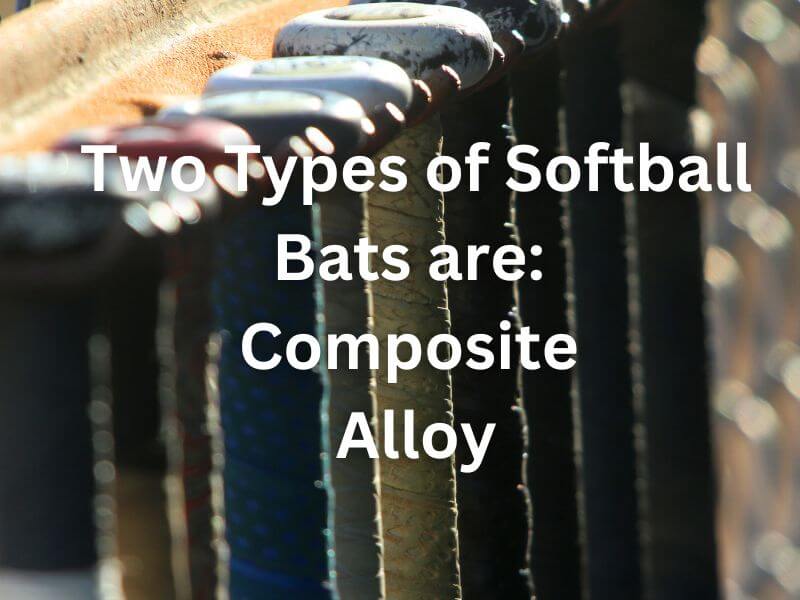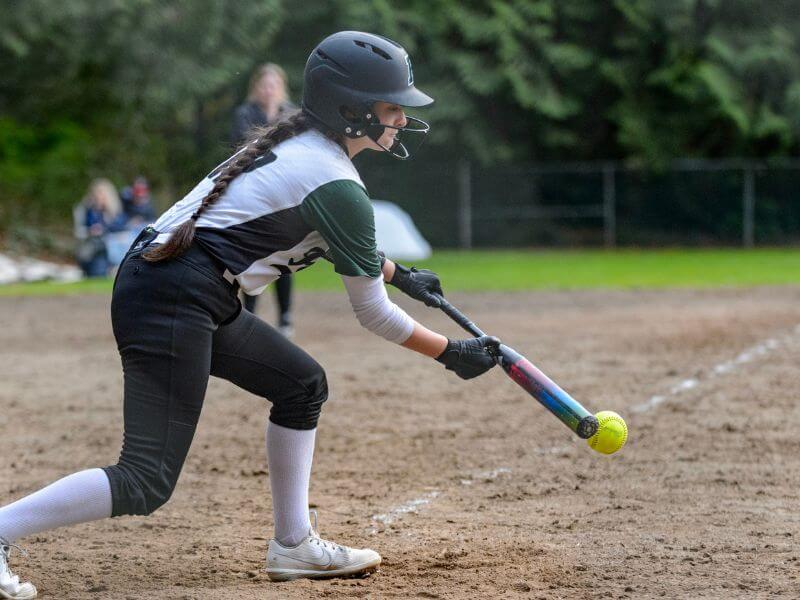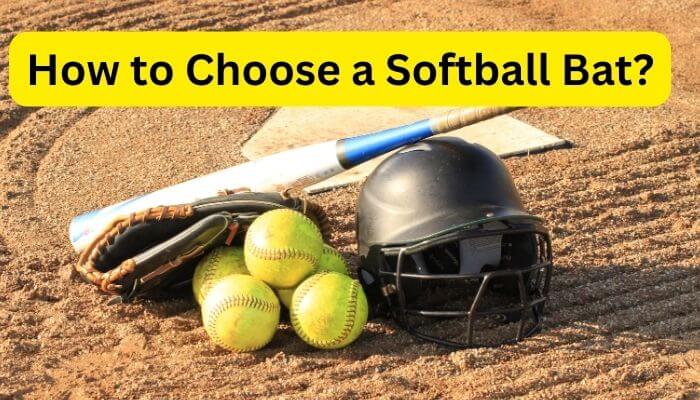Softball is one of the most popular sports in the United States, and it’s quickly becoming more popular internationally. If you’re interested in trying out this sport or starting out and want to buy your first softball bat, choosing the right one can be a bit confusing.
I have been coaching boys and girls for some time now, and my experience tells most boys and girls get confused about choosing a bat.
Your playing style is the most crucial factor to consider when choosing a softball bat. Do you prefer a heavier bat that will give you more power or a lighter one that is easier to control? And, of course, you’ll need to consider the size of your hand. Some bats are designed for smaller hands, and others are designed for larger hands.
In this article, I’ll outline the different types of bats available on the market and explain which is best for you.
How to Choose a Softball Bat?
Before making a purchase, I will tell you to understand the fundamentals of a softball bat. Because if you don’t understand the terms, it will be tough to understand which one to pick. Another important thing is the legal use of the bat you will purchase. Several organizations permit bats. So, you MUST follow their rules before buying a softball bat.
Organizations that permit bats are: International Softball Federation (ISF), USA Softball, Independent Softball Association (ISA), USSSA, NSA
Understanding the DROP
The drop of a softball bat is one of the essential elements to consider when purchasing a new bat. The drop refers to the Weight of a bat compared to its length. It is expressed as negative numbers and is measured by subtracting the length (in inches) from the Weight (in ounces).
For example, a 30″ -10 bat would be much lighter than a 34″ -5 bat. The ‘drop’ must range in a certain area set by each league, so it’s important to double-check with your team or league to ensure you get it right.
Let’s talk more about this because I often find many boys and girls find it tough to understand. Put, DROP is used to describe just how much lighter one bat is compared to another – it’s essentially a measurement of the difference between the length of the bat and its Weight.
For example, you’ll frequently see it measured in numbers such as -5 or -10. That indicates that one bat may have a DROP of -5, meaning it’s five ounces lighter than its length would indicate, and another has a DROP of -10, meaning it’s ten ounces lighter than what is indicated by its length measurement.
When it comes time to go shopping for your next softball bat, make sure you know what kind of DROP you’re looking for, then try out multiple bats until you find one that really swings well for your purpose!
Generally speaking, lower drops give better performance and more power for young players, but higher drops can offer quicker bat speed and improved control for more advanced players. Ultimately, choosing the correct drop comes down to player preference!
Different types of Bat Technology

Now come to the next part. Which types of bat should you purchase?
Softball has two leading bat technologies available to consumers: composite and alloy. Both of these materials offer a unique set of advantages and disadvantages regarding performance, durability, and cost.
Composite bats are usually made from graphite, Kevlar, or carbon fiber and have a very soft or flexible feeling. They produce more energy transfer with the ball, creating high amounts of power, but they have a relatively short lifespan and may require more maintenance than alloy bats.
Alloy bats are made from aluminum or titanium and tend to be sturdier than composite bats, with more excellent durability, good pop off the bat, and good balance. However, they generally cost more than composite models due to the higher manufacturing costs associated with producing them.
Composite bats come with a more prominent sweet spot, and you will not hear the huge “PING” sound you hear when using an aluminum bat.
There are other factors to consider when choosing a bat. Some people prefer a flexible bat, while others prefer a hard bat. Composite bats are generally more flexible than alloy bats but can also be harder.
Different types of Softball Bats

Youth Softball Bat
The youth softball bat size is surprisingly similar to the baseball bat size chart.
When finding a youth softball bat for your child, there are a few critical factors to consider. First, ensure the relevant governing body approves the bat – this will ensure that you don’t end up with something that won’t pass inspection. Secondly, it’s good to get an idea of the size and Weight of the bat before you buy it – this way, you can be sure that your child is comfortable and able to swing it properly.
Lastly, look for something made from quality material – this isn’t just about whether or not it will last – if you buy a top-of-the-line bat, chances are it will perform at its peak and make your child’s softball experience even more enjoyable!
But there are more suggestions for the sport of softball with what drop stick you should be using. Most research that you’ll find online suggests that ages 8 and under should use a -12 to a -14 stick, a -12 to a 10 for ages 8-14, and for 14 and older, an 11 to 8.
So for youth softball sticks, we should be looking at a -12 to a 14.
Slow-Pitch Softball Bat
Slow-pitch softball bats are perfect for players who want to have a slower ball speed. These bats have a thinner barrel and a smaller size than hard-ball bats. They are also easier to swing and control. This makes them perfect for players who want to practice their swings and techniques.
There are several different types of slow-pitch softball bats. The most popular ones are the 26-inch and 28-inch bats. They come in various kinds of wood, including maple, ash, and bamboo. These bats are also comfortable to swing. They have a thin barrel and a small size, which makes them easy to control.
Players who want to practice their swings and techniques should invest in a slow-pitch softball bat. These bats are perfect for players who want to improve their skills. They are also easy to swing, which makes them comfortable to use.
Finding the right slow-pitch softball bat can often seem daunting, but it doesn’t have to be! Remember a few key factors when shopping for your perfect bat. One of the most important things is typically the “drop weight” of the bat.
This measures how heavy or light the bat is compared to its length. Another factor to consider is whether you prefer an end-loaded or balanced bat, which will determine how much control and power you get from each swing.
Finally, always ensure that the material of your bat works for you both in terms of performance and budget. While there are tons of great options out there, with just a bit of research, you should be able to find the right one!
Fast-Pitch Softball Bat
I want to start this part by giving an introduction to fast-pitch softball.
Fast-pitch softball is a fantastic team game typically played by girls and young women. It requires lightning-fast reflexes and tremendous skill to fling that softball into the pitcher’s mitt from a distance of 40 feet. The typical batting order includes nine players, with each side taking turns swatting away at the ball until all batters have gone through their turn. Once a player has made it on base, she can either be called out or proceed to the next base in hopes of scoring a run.
Of course, the defense isn’t standing still either; they must work tirelessly to throw out anyone who makes it safely on base or even swipes up another. Fast-pitch softball takes practice, but once you get hooked, you’ll find yourself playing with friends and teammates for hours!
Now let’s learn how to pick a good fast-pitch bat.
Choosing the right fast-pitch softball bat is vital for any player looking to take their game to the next level.
What may be even more overwhelming than the sheer number of bats available on the market is all of the technology and terminology behind it! There are many factors to consider: shaving weight, aerodynamics, and alloy versus composite. Knowing your league regulations to identify its requirements and restrictions is the best place to start.
After that’s been determined, you can decide which size and material would work best for your own unique playing style. No matter what direction you go in, ensure that the bat is comfortable in your hands while providing maximum power and control when making contact with the ball – so choose wisely!
Some Important Tips while Choosing a Softball Bat
I hope now you have learned more about softball and which bat you should pick. But wait, there are some other tips because every person is not similar, right?
Length Vs. Height Check
Choosing the right softball bat can seem quite difficult when you first encounter the proliferation of sizes and shapes. But don’t worry. There’s an easy method to select the optimal one for you: look into the size of both your height and length!
The length of your bat should be based on your height because it should reach your hip region with it comfortably tucked in your hand. As for width or circumference, check the maximum diameter allowed for most leagues, then pick out a bat that fits within this limit.
The length of bats suitable for various players depends on their height. The size of your bat may affect your swing technique and plate contacts. For taller players, a longer bat provides greater comfort, and vice versa for shorter players. You can test if the bat is of the correct length by doing the following advice:
Arm Check: Place the bat’s bottom against your chest, so it rests comfortably between your arms. Make sure the bat is the right size; if it feels too big, you’re probably not tall enough.
Chest Check: Stand upright with the bat’s butt end resting against your chest. Hold the bat so that the handle is parallel to the ground. Keep your arms straight and hold the bat firmly. Don t allow the ball to hit your face.
Palm Check: It should be about the same size as your palm. If you’re uncomfortable holding it straight against your body, try holding it sideways instead.
So, before buying a bat, make sure the bat fits you. If you miss here, you will definitely suffer on the softball field.
If you are interested, you can read my blog on how to become a better slow-pitch softball hitter.
What Weight Should you Pick?
Choosing the right size and Weight of a softball bat can be tricky, but there are a few tips you should remember to help make the selection process easier.
To start, think about your swing speed. Heavier bats will have more power with better momentum as they travel through the air but require more effort for a player to hold onto and swing them.
Slight increases in Weight should give moderate boosts in the distance traveled, but too much-added Weight can slow down your swing motion and be difficult to maneuver.
On the other hand, lighter bats give you more control over faster swings without sacrificing much power behind it. If you’re looking for a great all-rounder bat that isn’t too heavy or light – choose one with an adjustable system allowing you to quickly change its Weight according to the game situation!
Choosing the right softball bat for your swing and size can be intimidating, but with the right advice, you can confidently settle on the perfect bat weight. When picking out a bat, consider where the majority of your hitting power comes from – wrists or arms.
If you rely more on wrist action, opt for a lighter bat that won’t feel so heavy as you wind up to make contact. But if your swings come mainly from strength in your arms, you can go for a heavier bat and still have enough control over momentum.
Ultimately, it’s all about finding a proper balance between comfort and power!
FAQs
- What is an End-Loaded Softball Bat?
An end-loaded bat is a softball bat with its weight distributed toward the end of the barrel to add an extra power punch to your swing. End-loaded bats are popular among experienced
players who have mastered the basics and want to take their hitting game up a few levels. Although they provide more power, they require better control due to their increased weight on one end. So essentially, if you’re looking to hit it out of the park with style, an end-loaded bat will give you just the right amount of oomph – which is something that can’t be bought with money! It’s like you get a free ticket to Slugger Town!
- What is a Balanced Bat in softball?
Bats with equal weight at both ends are known to be balanced bats. These bats make the bat seem lighter and allow you to swing it faster. Additionally, they feature a larger sweet spot, making them ideal for beginners.
Finding the perfect bat for softball can be a tricky task! Not only do the weight and length of a bat have to be just right, but the weight must be distributed evenly throughout its length.
This elusive piece of equipment is known as a balanced bat. Specifically, balanced bats are designed to provide players with maximum swing speed and balance. Achieving this “just right” sweet spot may require some trial and error, but it’s worth it for the extra power behind every hit!
Keep this golden information in your back pocket the next time you’re on the hunt for a new softball bat!
Conclusion
Whether you are a new or an experienced softball player, a good bat makes a huge difference. Therefore, finding the best bat for your league is more important. Even playing backyard softball, you will need a good bat. If you were looking for “How to choose a softball bat,” now you have all the answers.
Read Other Blogs
Demarini F3 Softball Bat Review | Are They Good?
Softball Bat Vs Baseball Bat: Differences You Don’t Know
Pitching for Beginners in Softball | 9 Basic Actions to Be a Pro
How to Choose a Softball Glove? | Are Slowpitch and Fastpitch Need Different Gloves?

Hello everyone. My name is Jason Butler, and I live in California, America. I was a professional AAA Minor League Baseball player. I lost my chance of playing MLB for injury issues, but I did not lose my love for baseball. I attended the coaching training program and am now working as a coach in a small school in San Diego.
I always love to share my experience and knowledge if that can help you. Play baseball, and stay fit.
